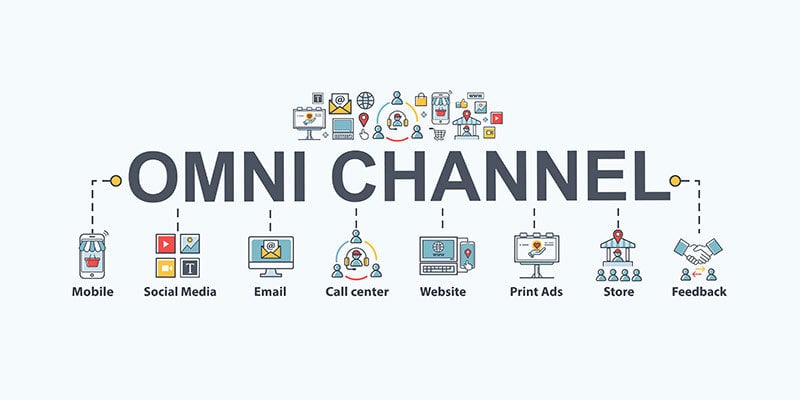
Listen to this blog
Mastering Cross-Channel Attribution for Marketing Success
Tracking qualified leads down the funnel from a single marketing channel is already a daunting task. Introduce a second channel into the mix, and you’re immediately raising the stakes.
If your marketing campaign spans multiple channels and you feel like manually tracking attribution is running you into the ground, you’re in the right place. Thankfully, with the rise of marketing automation technology, artificial intelligence (AI), and machine learning, identifying customer touchpoints and behaviors is more convenient than ever. In this guide, we’ll teach you how to connect your cross-channel marketing efforts to determine your true return on investment (ROI), plus tips on maximizing it.
What is Cross-Channel Attribution?
Cross-channel attribution is the process of accurately assigning credit to the marketing touchpoints contributing to sales across multiple channels. Businesses use cross-channel attribution to better understand the customer journey, optimize resource allocation, and refine marketing strategies for improved ROI. Let’s explore this concept further with some examples:
Cross-Channel Attribution: Online Retailer
Imagine an online retailer running marketing campaigns across various channels, including social media, email newsletters, and search engine advertising. By implementing cross-channel attribution, the company can track how each channel contributes to customer engagement and ultimately leads to sales. For instance, they may find that while social media drives initial awareness, email newsletters are more effective in converting leads into customers. Armed with this insight, the company can allocate resources more efficiently and tailor their marketing efforts to focus on the most impactful channels.
Cross-Channel Attribution: SaaS Company
A software-as-a-service (SaaS) company offers a free trial of its product and promotes it through multiple channels, including content marketing, webinars, and online advertisements. Using cross-channel attribution, the company can analyze how each touchpoint influences trial sign-ups and subsequent conversions to paid subscriptions. They may discover that webinars have a higher conversion rate compared to other channels, prompting them to invest more resources in hosting webinars and optimizing their webinar marketing strategy.
Cross-channel attribution empowers businesses to gain insights into the effectiveness of their marketing efforts across different channels, enabling them to make data-driven decisions to maximize ROI.
How Can Businesses Effectively Track ROI Across Multiple Marketing Channels?
Tracking ROI across multiple marketing channels requires a combination of tools, techniques, and best practices. Here are some strategies for effectively tracking ROI:
- Utilize Marketing Attribution Platforms: Invest in marketing attribution platforms that offer multi-touch attribution models to track and attribute revenue to various marketing touchpoints along the customer journey. These platforms provide insights into which channels and campaigns are driving conversions and revenue.
- Integrate CRM Systems: Integrate customer relationship management (CRM) systems with marketing attribution platforms to unify customer data and track the entire customer journey from initial touchpoint to conversion. This integration enables businesses to analyze the impact of marketing campaigns on customer acquisition, retention, and lifetime value.
- Implement Advanced Analytics Models: Use advanced analytics models, such as machine learning algorithms, to analyze large volumes of data and identify patterns and trends across multiple marketing channels. Adobe Analytics and other tools can uncover hidden insights and correlations that traditional analytics methods may overlook. Such tools require consistent, structured data that is pulled from multiple platforms and sources; this is where URLs created with BL.INK streamline the data to make such analysis seamless and accurate.
- Establish Key Performance Indicators (KPIs): Define clear KPIs aligned with business objectives, such as customer acquisition cost (CAC), customer lifetime value (CLV), and return on ad spend (ROAS). Track these KPIs regularly to measure the effectiveness of marketing campaigns across different channels.
- Optimize Attribution Models: Experiment with different attribution models, such as first-touch, last-touch, linear, time decay, and position-based attribution, to determine which model best reflects your business’s customer journey and marketing objectives. Adjust attribution models based on campaign goals and industry benchmarks.
By implementing these strategies, businesses can effectively track ROI across multiple marketing channels and make data-driven decisions to optimize their marketing efforts and maximize ROI.
Common Challenges Associated with Cross-Channel Attribution
Cross-channel attribution poses several challenges for businesses, ranging from data fragmentation to attribution modeling complexities. Here are some common challenges and strategies for overcoming them:
- Data Fragmentation: Businesses often struggle with fragmented data sources across multiple marketing channels, making it challenging to unify and analyze customer data effectively. To address this challenge, invest in BL.INK’s link management platform to standardize data across all sources to integrate into an analytics platform.
- Attribution Modeling Complexities: Determining the most appropriate attribution model for accurately assigning credit to marketing touchpoints can be complex. Experiment with different attribution models and methodologies to find the model that best aligns with your business goals and customer journey dynamics. Realize that attribution performance is different depending on your goals; some channels perform better for first-touch activities, for example.
- Privacy Regulations: Privacy regulations, such as the General Data Protection Regulation (GDPR) and the California Consumer Privacy Act (CCPA), impose restrictions on data collection and usage, limiting the availability of customer data for attribution analysis. Ensure compliance with privacy regulations and obtain explicit consent from customers for data collection and tracking activities.
- Channel Proliferation: The proliferation of marketing channels, including social media, email, search, and mobile, complicates cross-channel attribution analysis. Focus on identifying the most influential channels and prioritizing data collection and analysis efforts accordingly.
- Ad Blocking and Tracking Limitations: The prevalence of ad blockers and tracking limitations imposed by browser settings hinder the collection of accurate attribution data. Implement alternative tracking methods, such as server-side tracking or first-party cookies, to mitigate the impact of ad blockers and tracking restrictions.
By addressing these challenges proactively and implementing robust attribution strategies and technologies, businesses can overcome obstacles to effective cross-channel attribution and gain actionable insights into their marketing performance.
Different Types of Attribution Models Used in Cross-Channel Marketing
Cross-channel marketing attribution encompasses various attribution models, each offering unique insights into the contribution of marketing touchpoints to conversions. Here’s an overview of the most common attribution models:
- First-Touch Attribution: Attributes 100% of the credit for a conversion to the first touchpoint in the customer journey. This model is suitable for assessing the effectiveness of top-of-funnel marketing efforts in driving initial awareness and engagement.
- Last-Touch Attribution: Attributes 100% of the credit for a conversion to the last touchpoint before the conversion. This model emphasizes the final interaction that directly leads to a conversion and is often used in e-commerce and direct response marketing.
- Linear Attribution: Distributes credit evenly across all touchpoints in the customer journey, giving each touchpoint an equal share of the credit for the conversion. This model provides a balanced view of the customer journey but may not reflect the actual impact of each touchpoint.
- Time-Decay Attribution: Assigns more credit to touchpoints closer to the conversion event, reflecting the diminishing influence of earlier touchpoints over time. This model is suitable for assessing the relative impact of touchpoints at different stages of the customer journey.
- Position-Based Attribution: Also known as U-shaped attribution, this model assigns 40% of the credit to both the first and last touchpoints and distributes the remaining 20% of the credit evenly among intermediate touchpoints. This model acknowledges the significance of both initial and final interactions in the customer journey.
By using these attribution models effectively, businesses can gain valuable insights into the contribution of marketing touchpoints across channels and optimize their marketing strategies for improved ROI.
Conclusion
Cross-channel attribution is a critical component of modern marketing strategy. By accurately tracking and attributing credit to marketing touchpoints across multiple channels, businesses can gain a deeper understanding of the customer journey, optimize their marketing efforts, and maximize ROI.
BL.INK uniquely enables marketers to standardize data from any marketing channel, making it easier for tools such as Adobe Analytics to report accurately across these channels. Short links from BL.INK can point to anything—an email address, landing page, map—from anywhere—social posts, QR codes on printed materials, emails. The BL.INK platform enables you to collect and edit data “behind” each link to get accurate inputs from any marketing channel. And BL.INK delivers this level of standardized data much less expensively than Claravine or Accutics.
By implementing robust cross-channel attribution strategies, businesses can unlock valuable insights, make data-driven decisions, and ultimately achieve greater marketing success. Ready to learn more? Read our attribution e-book.
Let’s talk. Request a quote and set a meeting here.



